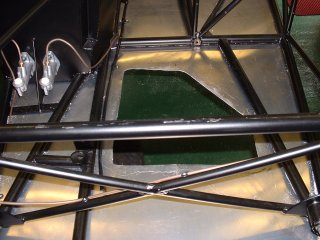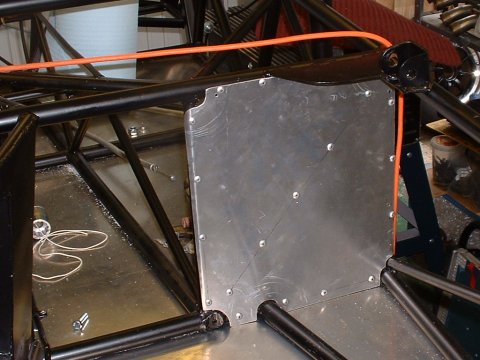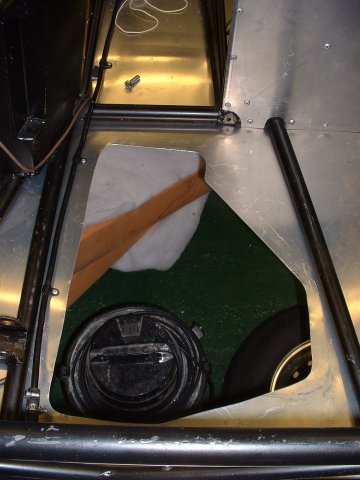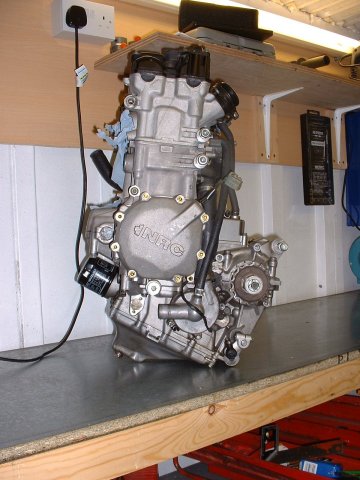home
introduction
build
sva tests
links
latest updates
Choosing the Engine
- Early January -
The first thing I did was read Rich Miles' website in detail, as he has documented there an assesment of the current favourite choices of engine for BECs. It didn't take my long to settle on the same engine that Rich had, the R1. It is light, powerful engine at 60kg and 150hp, doesn't need a dry sump conversion, and models after 2002 are fuel injected. (I don't understand carbs, I don't want to, I don't need to, don't try and explain them to me - they seem overly complicated and fiddly. Let's leave it at that.)
But then I hit a snag. I noticed that the 2004 R1 was due for release. It has an all new engine - very much more powerful at 180hp than the '02 and '03 versions, revs higher, lighter, more compact... It sounded perfect. Except that, as an all new engine, no-one, anywhere, knew whether or not it needed a dry sump conversion; If it did, no-one would have such a conversion kit available; it wasn't going to be available until March '04 earliest; Mark (who had bought the 21 off me) had already nabbed the first one due into the country for his new race car; and it was going to be (relatively) expensive at £2500, and that's even before the dry sump kit.
So, with some regret, I figured the '02/3 version would have to do. For now
But then, Stuart Taylor started posting details on their website of their '04 race cars. They'd chosen a GSX-R1000 engine for 2 out of the 4 of their cars. This is an engine that Rich hadn't writen very much about. It seemed good on paper - well at 160hp it did  . The gearing was good as well, but aside from little snippets on websites, I knew nothing else about it.
. The gearing was good as well, but aside from little snippets on websites, I knew nothing else about it.
The big attaction for me now, despite the unknowns, was that STM were using it, and would therefore hopefully be ironing out any installation and running difficulties in their own cars long before I had to start worrying about it.
The obvious thing to do was to go up to STM and ask Ian why they'd chosen it.
- February 10 -
When I asked Ian why they'd chosen the GSX-R1000 he shrugged and said that it seemed a good engine, widely used in sidecar racing, and that it didn't need a dry sump conversion. He showed me the modified baffle plate and sump that they were intending to use, and then pulled a particularly good trick.
They had bought an engine, sourced originally from a race bike, that they'd intended to fit to one of their cars. They realised afterwards that it had been ported, and hence was ineligible for use in the race series they wanted to use it in. He said I could have it for £**** (a very large amount), which I politely declined. Seeing his chance of ridding himself of an otherwise troublesome engine, he sucked his teeth, rolled his eyes, we bargained a bit, and I ended up the engine, the modified sump, clocks, loom, ECU and a refresh for the sum of £1850. So not a complete bargain when some other lesser engines are available for £750; but not bad either, especially as it would save me having to actually put some work into trying to source an engine 
Collection time
- April 30 -
The engine has been checked over, and his been given a clean bill of health. Dave pointed out that it was missing its throttle bodies, which was something I'd noticed before, but mentally filed away in a 'never to be thought of again' bin in my brain. Ian initially seemed sure that I had them, but then something sparked in his head and he remembered that he had a set with no engine, tucked away in a box. He also found the air box, in case I need to use it (I'm worried that noise will be too loud for SVA without it, but I'm also aware that it'll need a hole in the bonnet if I do use it 
News from STM
- May 11 -
On the phone, Ian mentioned that there'd been a bit of a development on the engine front - Martin Brooks has blown up his GSX R1000 again, and Ian now thinks that the engine could benefit from dry sumping.
It's beginning to look expensive  On the bright side, he is going to refund the money on the baffled sump, so I'm some of the way there...
On the bright side, he is going to refund the money on the baffled sump, so I'm some of the way there...
Ben, evo_him on the BEC list, recommended posting on the sidecar list, to see what they reckon. I may as well - nothing to lose!
Dry fitting the engine
- May 29 -
DH2 came round and helped me lower the engine in place. I put on the (now defunct) shallow sump, as the floor would have been in the way of the standard sump, but even so, the sump was resting on the floor. A small dent would accomodate it, but I'm sure the dry sump is going to be deeper, so it looks like a small hole is in order. It'll be nice to get a bit of cool air flowing over the sump, though, so I don't really mind. What I do mind is that I'll probably have to rig up some sort of sump guard, as it will be the only exposed item underneath the car.
At that point I realised that I don't have a propshaft adaptor to replace the bike's output sprocket, so I can't measure up for a prop anyway. I have a vague memory of Ian saying that it was included as part of the electric reverse, but I've been wrong before about things I thought I heard Ian say 
New Bits
- June 18 -
Whilst out at Hallens, I put in an order for some new gaskets for the clutch cover and flywheel cover - I 've not idea if they actually need replacing, but it seems to be a good general rule to replace gaskets when you can.
Engine weight
- August 21 -
I got around to weighing the engine today. Tricky to do with a set of bathroom scales limited to 135kg and no assistant, but a figure of 63kg seemed to be a repeatable value. That's without the throttle body assembly and airbox.
Engine in, engine out, engine in, ...
- August 28 -
With Alex's help, I spent a bit of time lifting the engine in and out of the car. Initially the idea was to cut a 1.5" hole in the right place for the sump pump pipe to stick out, but it became clear quite quickly that the new sump, even with the new cradle, needs to stick out under the floor a little bit. The hole became bigger and bigger and bigger...

- August 29 -
The Mighty Hackett, bless his cotton socks, was able to come round and help again today. We lifted the engine in and out a few more times, made the hole a bit bigger, and had a thinking session about the adaptors needed for the low pressure feed to the sump - it was clear that the 90° fitting that Karl had supplied wasn't going to clear the pedal box, and a 45 ° fitting at the tank end might make life a bit easier as well.
Must be getting serious
- September 11 -
The Mighty Hackett came round, and helped me to bolt the engine in place - it takes 2 as none of the mounting points on the engine cradle are in quite the right place, so it's helpful to have 1 person levering, bashing and clamping whilst the other tries to whack the bolts through the holes.
There's two more left to do, but the bracket for one of them has to be welded on, so I'll do that tomorrow; and I need to get hold of a 70mm M10x1.25 bolt for the other mount. According to my measurements I need a 200mm M11  bolt for the welded on mount. I suspect I'll get an M10 one instead, as it's just a clamping type of bolt rather than a threading into something type.
bolt for the welded on mount. I suspect I'll get an M10 one instead, as it's just a clamping type of bolt rather than a threading into something type.
Grrr - I forgot that I'd forget that
- September 12 -
I forgot that I'd need to rivet the passenger footwell panel in place before bolting the engine out. Fortunately Dave was free, so he came over and helped me take the engine out again and I riveted the panel in place.

Whilst I did that, Dave made an attempt to tidy up my tools, but failed because he was so upset by the mess. As consolation, I let him help me finish up the edges of the hole in the floor, which he really enjoyed 

For the record, the next (and final?) time we bolted the engine in, it was much easier than other times, so I conclude that the order we did the bolts was better - top front, bottom front, top foward front and top rearward front.
Dave looked at the electric reverse, and suggested bolting the drive flange in the other way around, to see if that helped with the clearance problem. It did, but reduces the engagement of the teeth when actually in the reversing position. Should be enough though, so I'll leave it that way round.
Remote mounting the oil pressure sender
- September 18 -
Onto a nice easy job - making up the flexible hose so that I can mount the OP sender off the block (where it'll get shaken apart by vibration). Now, you'd have thought that as the sender is a 1/8NPT thread, and the hole in the block is a 1/8NPT thread, then the adaptor would be relatively simple wouldn't you?
But no - this is the world of Thinkauto, where all jobs, no matter now simple, will require twice as many adaptors as you might have originally thought, at least one of which will make your wallet bleed. So the 1/8NPT needed a male to male converter to 1/8 BSP, as that's the only sort of connector that's available in a 90° bend (to come out of the block at a sensible angle) to go into a -3 hose. At the other end of the hose, there isn't a -3 to 1/8NPT female adaptor, so I had to get a male 1/8NPT fitting and a 1/8NPT female to female adaptor. In aluminium. Sigh.
misfire
- May 3 -
There is a misfire on cylinder #1. There always has been, occasionally, if the idle speed is set too low, but this is a continous misfire. I swap the injectors. No difference - exhaust header #1 stays stone cold. I swap the coils (each plug has it's own coil). No change. I swap the plugs. No change. I check the air bleed hoses. All tight. The ECU is not reporting any faults. Petrol is definitely getting in there, as occasionally it explodes and causes the throttle body to almost pop out of its rubber mount. A small bell rings in my head - upon close inspection, the #1 TB is sitting proud of the mount, relative to the others. I seat the TB firmly into the mount, and try the engine again. No misfire!
So now, I just have to figure out why it misfires at idle. The std GSXR idles at 1100 rpm hot, and 1800 cold, IIRC, but I have to set the idle at about 1500 hot to prevent the misfire and consequent TB explosion and seperation from mount. Anyone got any ideas? I wonder it someone has fitted some very wild cams to this thing and the idle needs to be higher to compensate. Doesn't seem likely to me. And why would it only affect one cylinder?
twiddling
- May 28 -
I think I've figured out the cold idle thing as well. I noticed that when the engine starts up, it always starts with the seconday throttles fully open, and then closes them a little as the engine warms up. There's a linkage that is actuated by the secondary throttles that bears on the secondary idle screw, which in turn opens the main throttle valves a crack wider; but it only comes into play at wide (secondary) throttle angles. Sooooo, I've set the secondary idle screw to a position where the engine will idle at 1800rpm whilst the secondary throttle is open, but once it closes, the engine will idle at the prescribed 1150rpm.
It's hard to tell if I've got it exactly right, as it's a warm day today, and the ECU quite quickly decides that it's OK to close down the secondary throttles.
This page last updated on: Sunday, Jul 16 2006
Date
aeroscreen
body
boot
brakes
chassis
cooling
clutch
dashboard
electrics
emissions
engine
exhaust
final drive
fuel system
gear shift
lubrication
mirrors
panelling
propshaft
reverse
seats
steering
suspension
throttle
trim
wheels
garage
